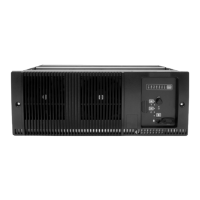136 Technical Description TB9100/P25 CG/P25 TAG Installation and Operation Manual
© Tait Limited March 2014
■ firmware upgrades
■ configuration (of operational parameters).
The I
2
C current source is located in the PMU so that the base station can
operate with the control panel removed. However, the PMU must be
powered up to enable the I
2
C communications to operate. Base stations
which use the 12V PA do not require a PMU, and in this case the I
2
C
current source is located on the base station subrack interconnect board.
RS-232 Signals Calibration Software serial communications occur directly between the
connected computer (or modem) and the reciter over the RS-232 serial
lines. When the connected computer needs to communicate with the PA,
PMU or control panel, the reciter routes the RS-232 data stream to the I
2
C
bus. Only reciters use the RS-232 interface.
Because RS-232 is a peer-to-peer physical interface, the control panel
converts RS-232 to open collector logic. Open collector logic allows the
control panel to communicate with the reciter. This same logic level
conversion is also performed in the Calibration Test Unit when the control
bus interface is connected directly to the reciter.
Fan Signals The power and ground signals for the PA and PMU fans are routed from the
modules to the front panel (via the control panel) along the system control
bus. These signals are electrically isolated from all other system signals to
ensure fan noise is not transferred to other sensitive system components.
Although the PA and PMU modules provide the power and ground for their
respective fans, the fan rotation detection is performed in the control panel.
The result is then read and processed by the reciter via the I
2
C interface.
The PA and PMU do not know if their fan has been correctly enabled,
however, if there is a fault in the fan circuitry, each module is protected from
overheating by its internal foldback circuitry.
Speaker Signal Received audio can be sent from the reciter to the control panel. This
function is controlled by the speaker button on the control panel. The audio
signal is then amplified and passed to the control panel speaker for
monitoring purposes. The audio output impedance of the reciter is fixed at
approximately 2k Ω.
Microphone Signal When you press the microphone PTT button, the reciter enables the
transmitter and connects the audio signal from the microphone input to the
modulator. The microphone PTT signal is read via the control panel using
the I
2
C bus and this then enables the transmitter. Note that the PTT
response times are slower than the response times for the Channel Seize
input from the analog interface.

